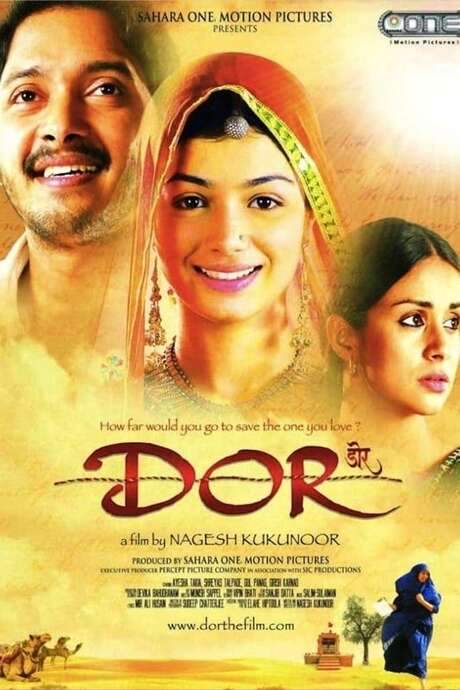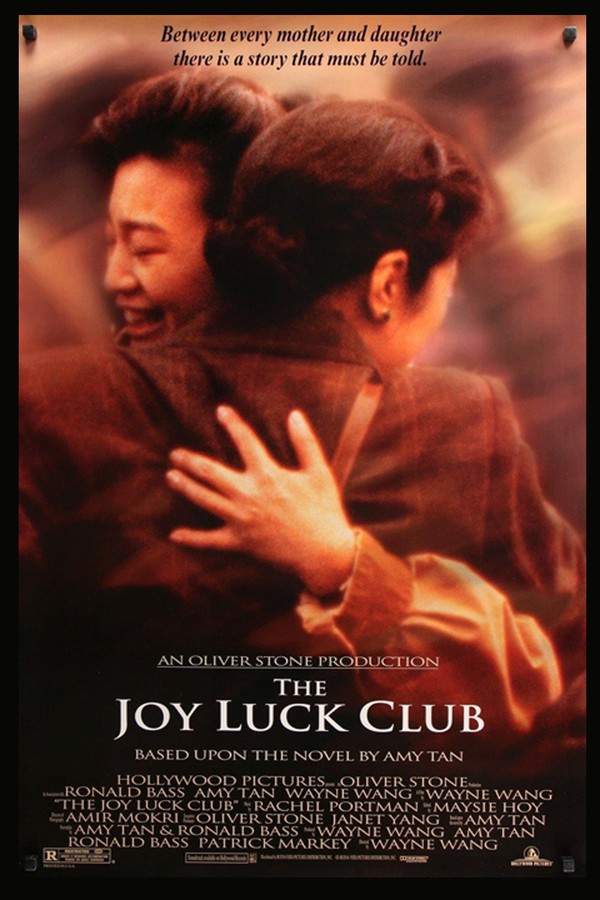
Dor
Year: 2006
Runtime: 124 mins
Language: Hindi
Director: Nagesh Kukunoor
Shankar Singh lives in Jodhpur with his wife Meera, grandmother Laxmibai, mother Gowri and father Randhir, feeling blessed by her presence. He goes to work in Saudi Arabia, promises to keep in touch and sends money that clears the family’s debts. When he stops contacting them, Meera learns he was thrown from a tenth‑floor balcony. Her fortunes reverse; jewelry is taken, she is forced to wear dark clothes and pray only at a temple.
Warning: spoilers below!
Haven’t seen Dor yet? This summary contains major spoilers. Bookmark the page, watch the movie, and come back for the full breakdown. If you're ready, scroll on and relive the story!
Dor (2006) – Full Plot Summary & Ending Explained
Read the complete plot breakdown of Dor (2006), including all key story events, major twists, and the ending explained in detail. Discover what really happened—and what it all means.
Zeenat Fatima is an independent Muslim woman living in the serene hills of Himachal Pradesh, where she begins a life with her boyfriend-turned-husband, Amir Khan, who soon leaves for work in Saudi Arabia. The separation sets the stage for a quiet, hopeful chapter in her life, marked by the smell of pine, winding roads, and the slow rhythm of mountain living. Meanwhile, in Rajasthan, Meera embodies a different, but equally strict, caste of tradition. She is a simple Hindu woman who follows centuries-old customs, married into a traditional Rajasthani family and bound to the routine of a grand haveli, where each daily chore is a thread in the fabric of a tightly controlled household. Her husband, Shankar, also works in Saudi Arabia, sending remittances back to sustain the family—father, grandmother, and Meera herself—until those payments stop and no word arrives.
The moment the remittances cease, a devastating rumor takes root: Shankar has died in a freak accident, allegedly connected to a Muslim roommate. The family’s grief morphs quickly into blame, casting Meera as the bearer of bad luck and the perpetual target of emotional strain as she navigates the ritual and social pressures that come with widowhood. In this climate, the process of mourning becomes a public performance, draining her of vitality and forcing her to confront a future that seems suddenly constrained by tradition.
Across the landscape, Zeenat learns that her own husband has been arrested in Saudi Arabia for murdering his roommate and that Amir’s execution could be imminent. An Indian officer explains a harsh Saudi law: release may be granted if the wife of the deceased forgives the killer. Left with only a photograph of Shankar and Amir as proof of their shared past, Zeenat embarks on a perilous journey to find Meera and appeal to a family she has never met. Early on, she encounters a Behrupiya, a gifted performer with a knack for disguise and deception, who turns out to be a calculating conman. He swindles Zeenat and steals her belongings, yet when the situation turns dire for her, the Behrupiya returns, moved by her plight and determined to help, using his artistic talents to navigate towns and clues.
Their search leads them to Jodhpur, where they finally locate the Singh haveli and the embittered family at its center. Zeenat pleads with the Singh clan to forgive Amir, but the family’s anger remains unshaken, and their refusal pushes her to leave in heartbreak. The plot twist thickens as the Singh family’s debts to Chopra, a local factory owner, become a bargaining chip. Randhir Singh, the patriarch, asks for more time to settle the debt, and in exchange offers a grim alternative: Meera could be handed over to Chopra as a way to erase the obligation. Randhir’s decision underscores the moral fog surrounding love, duty, and economic pressure.
When the news of the death sentence for Amir finally arrives, Zeenat is faced with a painful truth about the nature of her friendship with [Meera]. The revelation that their bond was built on false pretenses wounds Meera deeply, and she refuses to sign the maafinama, insisting that she wants to see justice served for the life she has lost and the life she has been forced to endure. The moment exposes a rift between the two women and within the larger ecosystem of a society that prizes forgiveness as a performative ritual over personal healing.
Despite the rupture, fate nudges the two toward a shared crossroads. Zeenat endures the sting of betrayal and accepts the unpredictable turns of life with quiet resilience, while Meera experiences a dawning awareness of her own agency. The realization that Randhir is willing to bargain with her future—essentially ready to trade her for relief from debt—sparks a decisive shift in her. She races to the railway station in a race against time, where she hands Zeenat the signed maafinama, the document of forgiveness she once refused to grant. In a poignant final image, Meera reaches out from the platform as the train pulls away, gripping Zeenat’s hand and stepping aboard, choosing a new life over the one she has always known.
The film closes on a note of cautious hope: two women, shaped by conscience, tradition, and the weight of expectation, opt for a future that refuses to be dictated solely by family or law. Their alliance—fragile yet transformative—suggests that mercy, when freely chosen, can unlock possibilities beyond rigid social scripts. Alongside these two central arcs, the film also features Uttara Baokar in a supporting role, adding depth to a story that probes the tension between duty and desire, communal norms and personal truth, all set against the textured backdrops of Himachal Pradesh and Rajasthan.
Last Updated: October 09, 2025 at 15:11
Explore Movie Threads
Discover curated groups of movies connected by mood, themes, and story style. Browse collections built around emotion, atmosphere, and narrative focus to easily find films that match what you feel like watching right now.
Movies about female solidarity like Dor
Women from different worlds unite to overcome oppressive circumstances.If you liked the story of female empowerment in Dor, explore more movies where women support each other through immense hardship. These films focus on resilience, shared struggle, and the transformative power of female bonds against oppressive cultural or societal forces.
Narrative Summary
These narratives often begin with women isolated by loss or societal constraints. Their paths cross, revealing a shared struggle. Through mutual aid and understanding, they find the collective strength to challenge their fate, navigating a system that seeks to keep them apart.
Why These Movies?
These films are grouped by their central theme of female connection as a catalyst for change. They share a heavy emotional weight, a focus on character-driven resilience, and a tone that balances despair with the hope found in human connection.
Movies about bittersweet escapes like Dor
Journeys where freedom is achieved, but at a significant personal cost.Find movies similar to Dor, where characters fight for freedom from dire situations. These narratives involve high stakes, emotional hardship, and conclusions that are hopeful yet tempered by the price paid for liberation, perfect for viewers who appreciate earned, complex endings.
Narrative Summary
The narrative follows a protagonist weighed down by systemic or personal tragedy. The plot is a steady build of tension as they seek a way out, often requiring a difficult moral choice or relying on an unexpected ally. The climax brings liberation, but the victory is never pure, always acknowledging the scars of the journey.
Why These Movies?
This thread connects films through their shared emotional arc: a progression from deep despair to a hard-fought, imperfect freedom. They consistently blend a high-intensity, heavy mood with a ultimately bittersweet resolution, creating a profoundly moving and thought-provoking experience.
Unlock the Full Story of Dor
Don't stop at just watching — explore Dor in full detail. From the complete plot summary and scene-by-scene timeline to character breakdowns, thematic analysis, and a deep dive into the ending — every page helps you truly understand what Dor is all about. Plus, discover what's next after the movie.
Dor Timeline
Track the full timeline of Dor with every major event arranged chronologically. Perfect for decoding non-linear storytelling, flashbacks, or parallel narratives with a clear scene-by-scene breakdown.

Characters, Settings & Themes in Dor
Discover the characters, locations, and core themes that shape Dor. Get insights into symbolic elements, setting significance, and deeper narrative meaning — ideal for thematic analysis and movie breakdowns.

Dor Spoiler-Free Summary
Get a quick, spoiler-free overview of Dor that covers the main plot points and key details without revealing any major twists or spoilers. Perfect for those who want to know what to expect before diving in.

More About Dor
Visit What's After the Movie to explore more about Dor: box office results, cast and crew info, production details, post-credit scenes, and external links — all in one place for movie fans and researchers.




























